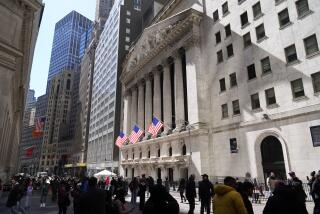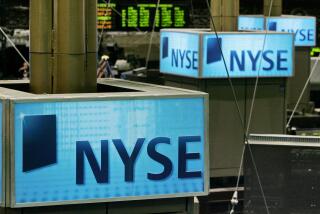Stocks eke out gains in abbreviated trading day
Major U.S. stock indexes ended mostly higher on Wednesday, with the Dow Jones industrial average adding modestly to its gains a day after closing above 18,000 for the first time.
It was the Dow’s sixth straight gain, coming during a half-day trading session ahead of the Christmas holiday.
Investors welcomed Labor Department data showing that applications for unemployment benefits fell last week to the lowest level in seven weeks. The news came a day after the Commerce Department estimated that the economy grew in the July-September quarter at the fastest pace in 11 years.
The unemployment data show steady improvement in the labor market, which is positive news for the economy.
“We’re still giddy after yesterday’s GDP (report),” said Chris Gaffney, a senior market strategist at EverBank Wealth Management. “That’s what’s mainly driving this market.”
The Dow gained 6.04 points Wednesday to close at 18,030.21. That’s up 0.03 percent from a day earlier.
The Standard & Poor’s 500 index slipped 0.29 points, or 0.01 percent, to 2,081.88. That’s slightly below the S&P’s most-recent all-time high recorded on Tuesday.
The Nasdaq composite added 8.05 points, or 0.2 percent, to 4,773.47.
U.S. government bond prices rose. The yield on the 10-year Treasury note dipped to 2.26 percent.
The Dow and S&P 500 have recovered the last of the ground they lost in an early-December slump.
The stock market got off to a positive start early Wednesday following the labor market report and held onto to its gains throughout much of the abbreviated trading session. Shortly before the stock market closed at 1:00 p.m. Eastern Time, the S&P 500 turned lower.
The stock market has been mostly trending higher the last two weeks after hitting a recent low of 17,069 on Dec. 16 as traders worried about plunging oil prices and a sharp drop in Russia’s currency.
Investors have been encouraged by corporate earnings growth and signs of a strengthening U.S. economy.
Consumer spending and personal income have been rising. The economy also has been creating more jobs. In the first 11 months of this year, employers have added 2.65 million jobs. That already makes 2014 the best year for hiring since 1999.
In addition, remarks last week by the Federal Reserve reassured investors that the central bank won’t raise interest rates soon.
With just one week left until 2015, the S&P 500 is up 12.6 percent this year, not including dividends, while the Dow is up 8.8 percent. The Nasdaq is up 14.3 percent.
“We’ll look for more volatility next year, but we still expect a buy-on-the-dips, grind-higher equity market,” said Terry Sandven, chief equity strategist at U.S. Bank Wealth Management.
Utilities stocks were among the biggest gainers Wednesday. The sector is up 26.4 percent this year. Investors often turn to utilities as a safe haven during periods of market volatility.
“Possibly, people just want to get a bit more defensive in respect to their gains going into the end of the year,” Gaffney said.
Seven of the 10 sectors in the S&P 500 fell, with energy stocks declining the most. The sector has fallen 8.9 percent this year as the slide in oil prices has deepened.
The price of benchmark U.S. crude oil fell $1.28 to close at $55.84 a barrel in New York. Brent crude, a benchmark for international oils used by many U.S. refineries, fell $1.45 to close at $60.24 a barrel in London.
Oil prices have been a major focus in markets over the past few weeks as they have fallen by about a half since the summer.
In other futures trading on the NYMEX:
— Wholesale gasoline fell 5.8 cents to close at $1.513 a gallon.
— Heating oil fell 6.7 cents to close at $1.924 a gallon.
— Natural gas fell 14.1 cents to close at $3.030 per 1,000 cubic feet.
In metals trading, gold fell $4.50 to $1,173.50 an ounce, silver fell 6 cents to $15.71 an ounce and copper fell a penny to $2.85 a pound.
U.S. stock markets reopen on Friday.





